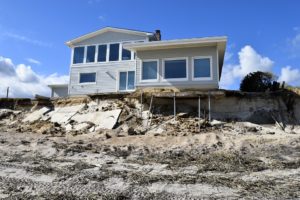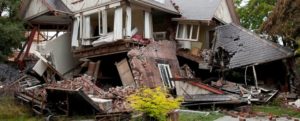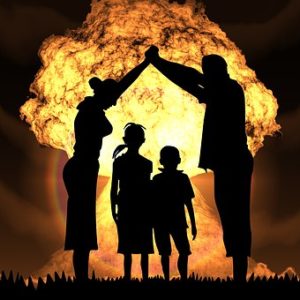Many people don’t understand what is not included on their standard Homeowners Insurance policy until it’s too late. Some homeowners only think short-term and opt for the minimum requirements on their mortgage. While there’s no one type of catastrophic insurance that covers everything, there are a few that are crucial to have. Most victims of natural disasters never imagined that they’d lose their home and belongings to a flood, earthquake or wildfire. People often skim over Flood Insurance and Earthquake Insurance, even after an agent explains that they won’t be covered with a standard Homeowners Insurance policy.
Overestimating our luck is often why insurance fails us. Having some Homeowners Insurance doesn’t cover it all. If you’re not sure what coverage you have on your policy, then contact an Insurance Specialist at (888) 772-4247.
Flood Insurance
Flood Insurance is one most people assume is included in a standard Homeowners Insurance policy. Most people also assume that flooding in their home is unlikely. But, consider Hurricane Harvey, Hurricane Irma and Hurricane Maria. They are proof that we never know what kind of natural disaster could cause flooding. Flooding still costs Americans billions in damages each year. Far too many people in Texas and Florida didn’t have Flood Insurance.
Many California residents also wrongly think they are immune to floods because the state is often in a drought. However, many areas of California are prone to flooding and flash floods. Most of the losses people and businesses suffer in a natural disaster result from flooding.
National Flood Insurance Program
Flood Insurance is subsidized by the federal government. In 1968, the National Flood Insurance Program (NFIP) was created to help lessen the burden of the losses suffered due to flood damages. Most people living in flood-prone areas are highly encouraged to obtain an NFIP policy. However, you must follow the rules and regulations required to get coverage. Most policies written under the NFIP are subject to a 30-day waiting period after signing before the coverage takes effect. But, if you live in a mandatory flood zone, there is no waiting period.
Policy Limits & Deductibles
 Flood Insurance, like most other types of insurance, has policy limits and deductibles. The average NFIP policy has $250,000 worth of coverage on a home, condo or other dwelling. With that comes an additional $100,000 for the contents of the home. The deductible on this policy would be roughly $500, with structures prior to 1978 doubling to a $1,000 deductible. You can always customize your policy based on what you estimate it would cost to rebuild your dwelling, or if you know your contents have a greater value than $100,000. You can also choose to buy coverage for only the dwelling or only for the contents of your home.
Flood Insurance, like most other types of insurance, has policy limits and deductibles. The average NFIP policy has $250,000 worth of coverage on a home, condo or other dwelling. With that comes an additional $100,000 for the contents of the home. The deductible on this policy would be roughly $500, with structures prior to 1978 doubling to a $1,000 deductible. You can always customize your policy based on what you estimate it would cost to rebuild your dwelling, or if you know your contents have a greater value than $100,000. You can also choose to buy coverage for only the dwelling or only for the contents of your home.
NFIP Insurance Rates
As for rates, the NFIP has three categories it uses to rate risk according to the location of the property. They are Low, Moderate and High. A Preferred Risk Policy offers lower rates only for people who live in low to moderate risk areas. This type of policy will run anywhere between $32 and $38 a month, but homes with a basement cost roughly $50 more a year.
Pricing gets more complicated for dwellings located in high-risk areas. This Standard Rated Policy is often mandatory if the homeowner has a mortgage through a federally insured or regulated lender. It must be purchased using FEMA’s General Property form, found here. Factors used to determine your rate for a premium include number of floors, building occupancy, year built, location of contents/valuables and the location of the lowest level to the flood map elevation requirements. For those interested in seeing where their risk category lies, you can search the flood map for your location on the FEMA website, by visiting here.
Earthquake Insurance
Many scientists believe that the recent hurricanes in the U.S. and the earthquakes in Mexico indicate there are more natural disasters to come. Earthquakes can be especially devastating and cause you to lose nearly everything you have. Like Flood Insurance, Earthquake Insurance is not included on a standard Homeowners Insurance policy. Earthquake Insurance isn’t just for homeowners either. Condo owners, mobile homeowners and renters may also buy this type of protection to cover damages to personal belongings. They also buy it to cover living expenses while their dwelling is being rebuilt or repaired.
California Earthquake Insurance
Insurance agents in California are required by law to tell their clients that they need Earthquake Insurance to cover earthquake-caused damages. However, many people still assume damages to their home are covered by their Homeowners Insurance. The only loss that would be covered by a standard Homeowners Insurance policy is fire damage caused by the earthquake. This is also only true in California. In other states, you are not even covered for fire damage.
Limits & Coverage
 Earthquake Insurance is set up to pay the amount required to rebuild a home, not it’s actual value. So, like other types of insurance, there are limits to what is covered. A basic California Earthquake Insurance policy is a three-part coverage, with renters only needing to buy the second and third parts.
Earthquake Insurance is set up to pay the amount required to rebuild a home, not it’s actual value. So, like other types of insurance, there are limits to what is covered. A basic California Earthquake Insurance policy is a three-part coverage, with renters only needing to buy the second and third parts.
Up to limits and after the deductible, the three parts cover:
- The dwelling
- Contents in the home
- Living expenses and loss of use of the insured home
Additional Coverage
You can always buy up to $30,000 additional coverage on top of the basic plans offered in California. The California Earthquake Authority (CEA) offers a Homeowners Choice Policy which allows you to have a separate coverage for your dwelling and your personal property. Both deductibles would not be applied to the same claim, however. The CEA usually waives the personal property deductible because damages exceed the deductible for dwelling coverage. You do have choices, so take some time thinking about actual value amounts.
Earthquake Insurance Rates
Rates for Earthquake Insurance vary greatly. Factors that determine your rate include the cost to rebuild your home and it’s location. The deductible you choose and the coverages you elect will also affect how much you pay.
Note that if an earthquake causes flooding, you aren’t covered for related damages unless you have a separate Flood Insurance policy. Also, your car is not covered unless you have Comprehensive Insurance on your Auto policy. Another thing to remember is that after an earthquake, insurance companies cease selling coverage for some time. Once it’s offered again, the premiums are usually higher. Thus, it’s best to buy insurance before you really need it.
Wildfire Insurance
 By mid-September, there were wildfires burning in 10 Western states. Two firefighters also died in Montana while many buildings and homes were destroyed in California. Burbank residents were forced into Los Angeles while their homes burned. 150 hikers were recused in Oregon when a fire began closing in on them. Utah and Washington began burning, and even Alaska experienced wildfires in its western rangelands. However, some of these states have not seen a wildfire of this magnitude in decades.
By mid-September, there were wildfires burning in 10 Western states. Two firefighters also died in Montana while many buildings and homes were destroyed in California. Burbank residents were forced into Los Angeles while their homes burned. 150 hikers were recused in Oregon when a fire began closing in on them. Utah and Washington began burning, and even Alaska experienced wildfires in its western rangelands. However, some of these states have not seen a wildfire of this magnitude in decades.
California has always been susceptible to wildfires, but still not everyone has a reliable Homeowners Insurance policy. Government catastrophe aid is never enough to rebuild homes. This makes the right insurance the best protection against a destructive wildfire.
Wildfire Protection Programs
Some insurance companies, like Safeco and Chubb, offer programs created to protect against a wildfire crisis. They often send crews to set up fire safety areas around your home to protect against encroaching fires nearby. There are also steps you can take to protect your home yourself. For tips on how to create a defensible space, creating an evacuation plan and creating an emergency supply kit, visit here.
Wildfire Insurance Coverage
Check in with your Insurance Specialist every year to go over your Homeowners Insurance coverage and limits. This is especially important if you’ve made changes or built additions to your home. Make sure all information, including square footage, is exact and accurate. These considerations are used to approximate how much you will need to rebuild your home.
Also, find out if you have a Replacement Cost Policy or an Actual Cash Policy. One takes depreciation value into account while the other pays out the market value of a home. Figure out which one benefits you more. Then, make sure your Insurance Specialist has you elected for the correct type of policy.
Call A Homeowners Insurance Specialist
If you think you’re paying too much, then learn more about bundling your insurance products for maximum savings. The best way to do this is by calling an Insurance Specialist at (888) 772-4247. Don’t gamble on your luck to save money. Be protected against wildfires, flooding and earthquakes on your Homeowners Insurance policy.
This content is offered for educational purposes only. It does not represent contractual agreements and it should not replace manuals or instructions provided by the manufacturer or the advice of a qualified professional. The definitions, terms and coverage in a given policy may be different than those suggested here. Such policy will be governed by the language contained therein, and no warranty or appropriateness for a specific purpose is expressed or implied.

